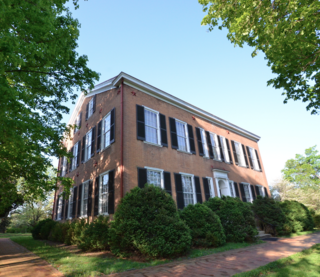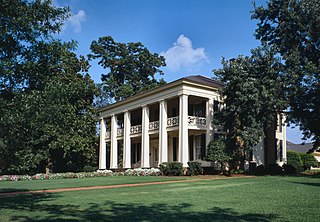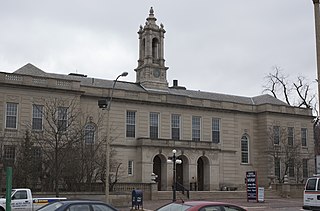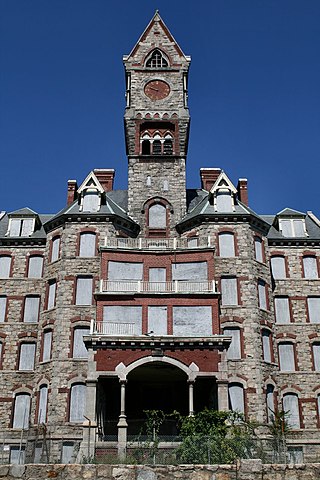
Arlington is a town in Middlesex County, Massachusetts. The town is six miles (10 km) northwest of Boston, and its population was 46,308 at the 2020 census.

The Citadelle of Quebec, also known as La Citadelle, is an active military installation and the secondary official residence of both the Canadian monarch and the governor general of Canada. It is located atop Cap Diamant, adjoining the Plains of Abraham in Quebec City, Quebec. The citadel contains the oldest military building in Canada and forms part of the fortifications of Quebec City, which is one of only two cities in North America still surrounded by fortifications, the other being Campeche, Mexico.

My Old Kentucky Home State Park is a state park located in Bardstown, Kentucky, United States. The park's centerpiece is Federal Hill, a former plantation home owned by United States Senator John Rowan in 1795. During the Rowan family's occupation, the mansion became a meeting place for local politicians and hosted several visiting dignitaries.

Arlington Antebellum Home & Gardens, or Arlington Historic House, is a former plantation house and 6 acres (24,000 m2) of landscaped gardens near downtown Birmingham, Alabama. The two-story frame structure was built between 1845–50 and features antebellum-era Greek Revival architecture. The house serves as a decorative arts museum, featuring a collection of 19th-century furniture, textiles, silver, and paintings. The garden features a restored garden room that is used for special events. The house was added to the National Register of Historic Places on December 2, 1970, as Arlington, and has also been known as the Mudd-Munger House.

The Old Schwamb Mill is an historic 19th-century mill at 17 Mill Lane in Arlington, Massachusetts. It claims to be located on the oldest continuously-used mill site in the United States, with a documented history of operation dating back to about 1684. The current mill building, erected in 1861, is now a living history museum. The property was listed on the National Register of Historic Places in 1971.

The Boston Consumptives Hospital is a historic tuberculosis hospital in the Mattapan neighborhood of Boston, Massachusetts. It consists of a complex of eighteen historic buildings on 52 acres (21 ha) of land. Most of these buildings were built between 1908 and 1932, although the Superintendent's House predates the hospital's construction; it is an Italianate house built c. 1856. They are predominantly brick buildings that are Colonial Revival in character, although the 1929 main administration building has a variety of different revival elements. Several of the buildings on the campus—The Administrative or Foley Building; The Doctor's Residences, Dormitories and Wards; and The Power House—were designed by the renowned architectural firm Maginnis and Walsh. The complex was the largest tuberculosis hospital in the state, built in response to reports that the disease was responsible for more deaths than any other in the city. The facility was used for the treatment of tuberculosis through the middle of the 20th century, and then stood largely vacant until 2002, when plans were laid to rehabilitate the property for other uses.

The Arlington Center Historic District includes the civic and commercial heart of Arlington, Massachusetts. It runs along the town's main commercial district, Massachusetts Avenue, from Jason Street to Franklin Street, and includes adjacent 19th- and early 20th-century residential areas roughly bounded by Jason Street, Pleasant Street, and Gray Street. The district was listed on the National Register of Historic Places in 1974.

The Arlington Gaslight Company is an historic industrial complex in Arlington, Massachusetts. It is one of the town's few large-scale examples of industrial architecture, built for a local fuel company in 1914. The three-building facility presently houses the town's public works department. It was listed on the National Register of Historic Places in 1985.

The Baptist Society Meeting House is a historic former Baptist meeting house in Arlington, Massachusetts. Built in 1790, it is the town's oldest surviving church building. Now in residential use, the building was listed on the National Register of Historic Places in 1985.

Calvary Methodist Church is a historic Methodist church building at 300 Massachusetts Avenue in Arlington, Massachusetts. Built in 1919-23, the building is a near replica of Boston's Kings Chapel, executed in wood. Its tower is topped by a belfry designed by architect Charles Bulfinch in 1809 and built for use on Boylston Market; it was rescued from demolition and given to the church in 1921. The building was listed on the National Register of Historic Places in 1983.

The Lt. Benjamin Locke Store is a historic building in Arlington, Massachusetts. It currently functions as a four-family private residence. The 2+1⁄2-story wood-frame structure was built in 1816 by Lieutenant Benjamin Locke, son of Revolutionary War veteran Captain Benjamin Locke. He established it as a shop to take advantage of the recently established Middlesex Turnpike, which ran past its door. It was converted into a four-family residence in 1854, a role it continues to serve. In 1912, the house was designated as a "pest house" during a smallpox outbreak, but its use was not required.

The Edmund Dwight House is a historic house at 5 Cambridge Street in Winchester, Massachusetts, straddling the town line with Arlington. It was built in 1858 in an Italianate style. It was one of the first and grandest country houses built in Winchester at a time when Boston businessmen were seeking to build such houses. Edmund Dwight, the wealthy businessman who was its first owner, was married to a great-granddaughter of Thomas Jefferson. The house's design is believed to be based loosely on that of Jefferson's Monticello. The house is sited for an expansive view of the Upper Mystic Lake. This residence was also home to Claude Shannon, the father of Information theory, and his wife Betty Shannon. While living there, they installed a chair lift that took the rider from the home down to the lake.

The Highland Park General Hospital is a former hospital complex located at 357 Glendale Avenue in Highland Park, Michigan. It was closed in 1976 and designated a Michigan State Historic Site in 1979 and listed on the National Register of Historic Places in 1985. The hospital primarily served African Americans. The building was later renovated into apartments, and is now the Bella Vista Glen Senior Apartments.

Norwichtown is a historic neighborhood in the city of Norwich, Connecticut. It is generally the area immediately north of the Yantic River between I-395 and Route 169.

Worcester State Hospital was a Massachusetts state mental hospital located in Worcester, Massachusetts. It is credited to the architectural firm of Weston & Rand. The hospital and surrounding associated historic structures are listed as Worcester Asylum and related buildings on the National Register of Historic Places.

The old Bourne High School is a historic school building at 85 Old Cotuit Road in Bourne, Massachusetts. Built in 1905 and enlarged in 1937, it is a prominent local example of Colonial Revival architecture. Most recently used by the town as the Kempton J. Coady Jr. Junior High School, it was by the local Waldorf school, and is now being converted to residences. It was listed on the National Register of Historic Places in 2013.

Mount Vernon Triangle is a neighborhood and community improvement district in the northwest quadrant of Washington, D.C. Originally a working-class neighborhood established in the 19th century, present-day Mount Vernon Triangle experienced a decline in the mid-20th century as it transitioned from residential to commercial and industrial use. The neighborhood has undergone significant and rapid redevelopment in the 21st century. It now consists mostly of high-rise condominium, apartment and office buildings. Several historic buildings in the neighborhood have been preserved and are listed on the National Register of Historic Places. Mount Vernon Triangle is now considered a good example of urban planning and a walkable neighborhood.




















